Game Mechanics: How to make a great word game
Last week we went through lots of examples of game mechanics and published games that make players feel smart. This week’s article is on how to make a great word game, and not surprisingly, ties in well to many of the same game mechanics we looked at in last week’s article.
We should first start by defining what a word game is. Most games do involve words in some way, and there some games like Codenames and Just One that are about guessing words. However, I think of word games a little differently.
What I’m really talking about here are word-building games.
I like to define word games as those that are all about trying to come up with words based on the letters you have available, which are really all about problem-solving, just in a way you might not have thought of before. When you come up with a great word, you feel smart and really good about yourself.
But at the same time, word games can be very think-y and may lead players to analysis paralysis (AP).
So, we’re going to look at examples of how to make a great word game, along with what game mechanics to avoid.
Some Things to Avoid
Scrabble is probably the world’s best-selling and well-known word game. It was originally released in 1938 at a time where there weren’t a ton of board games available and it was the only one all about making words with the letters you had available.
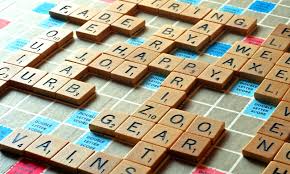
However, when you analyze Scrabble, you see that it has some flaws.
One of the biggest issues is downtime. It can often take a player several minutes to come up with not only a word but also a location on the board that they can place that word. That’s because they have 7 letters to work with and many different locations on the board where a word can be placed. They also have to be able to build off at least one letter on the board to make that word.
This can cause quite a bit of analysis paralysis (AP). Not only that, but while other players can look at their letters and think about what they might do with them, the board state will often change considerably by the time it comes around to their turn. They will often no longer be able to place their letters as they had planned. This leads to a lot more thinking by the current player and much more waiting by all the other players.
Many of these negatives could be avoided by having separate boards or play areas for each player rather than a common board, as well as speeding up turns by allowing for simultaneous play and a smaller space for decision-making.
Still, modern word games might not have existed if it weren’t for Scrabble. We must give credit to those who have come before and set the stage.
Let’s look now at how word games have evolved and the game mechanics they have employed to create a more engaging experience.
Modern Word Games
Word games have evolved a lot since the days of Scrabble. While not considered “modern” anymore, Boggle was released in 1973 and introduced a fast, simultaneous word game with players writing down all the words they saw in a short period.
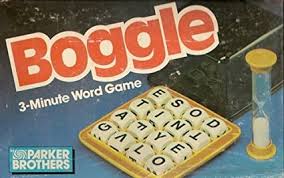
Much like Karuba, Scarabia, Cartographers, Planet Unknown, and Number 9, all mentioned in my previous article, in Boggle, all players have the exact same information to work with but will see things differently and will come up with their own unique words. In fact, only unique words will score. If you write down the same word as any other player, it gets crossed off and you won’t score any points.
Wordsy (originally released as Prolix), uses a system where all players are trying to make the best word they can with the eight consonant cards in front of them and any vowels they require. Similar to Scrabble, letters are worth different values, so you’re trying to score the highest point word each round.
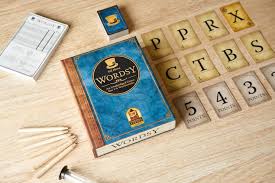
Bananagrams is like Scrabble on speed. All players build their own crossword-like setup, using the letter tiles that they draw. Everyone plays simultaneously and the faster you go the harder you make it on your opponents, as they must draw an additional tile every time any other player places their last tile.
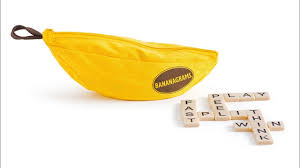
Word games continued to evolve, making use of cards with letters represented on them and allowing players to build words with what they have available. Tim Fowers added a twist when he created Paperback and Hardback, which incorporate deckbuilding, something normally reserved for more strategic card games like Dominion and Star Realms.
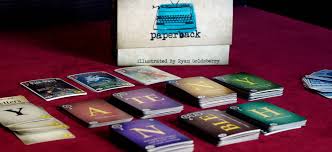
I discovered Letter Jam at Fan Expo in 2019 and later picked up a copy when the memory of playing it came to my mind. I remembered enjoying playing this and since it was a relatively cheap game to buy, I couldn’t say no!
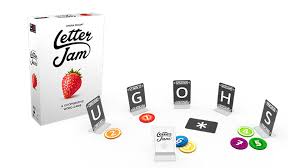
Letter Jam is a rare co-operative word game where you’re trying to guess the letter in front of you, which only other players can see. You first come up with a five-letter word (one letter per card), shuffle your cards, and pass them to the player on your left.
Then everyone displays one letter in front of them and your teammates come up with words based on the letters in front of each other, as well as some non-player letters. It’s up to you to determine what letter is missing in that word so that you can figure out your own letter.
You do this multiple times to try to uncover the five letters in your word and then you have to unscramble them to come up with the original word that your teammate passed to you at the start of the game.
It’s not the easiest game to describe in words. You really have to try it out and see it in action. But I can say it’s a whole lot of fun! It uses clues, guessing, and hidden information to create a fun and challenging experience.
What word game do you love and what game mechanics does it use to create an engaging experience?
Please share this with me and other readers by leaving a comment.
Next week we’ll be looking at ways to ensure your players are engaged.

4 comments
Jesse Fernandez
I love Boggle, but I haven’t played that game in 20+ years.
The most current game I playtested is with the designer:Tommy Byrd. He has designed a word game titled: Flippity Flop. My nephew has also played the game during a live playthrough with the designer as I at the same time in a messenger live stream. We three had a blast.
Our friend Tommy is currently busy with life, but ask him sometime to show you his game: Flippity Flop.
Joe Slack
Thanks, Jesse! I’ll have to check out Flippity Flop sometime.
Rod Currie
While separate boards would fix the downtime problems with Scrabble, it would also remove the ability to defensively block your opponents’ access to commonly letters and score multipliers. I also have a certainly fondness for games within an ever-changing play space that you only partially control.
Joe Slack
Great points, Rod! While making changes might speed up the game and reduce downtime, you’d lose player interaction. Whenever you change an aspect of a game, it will have impacts elsewhere. Sometimes the trade offs are worth it and sometimes not. Always good to keep these things in mind as a game designer!